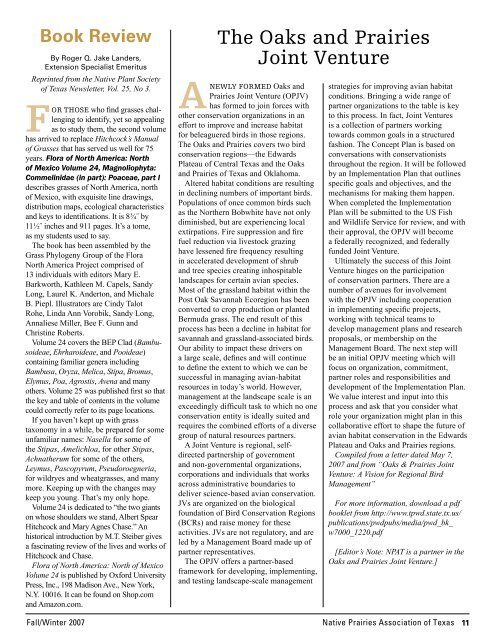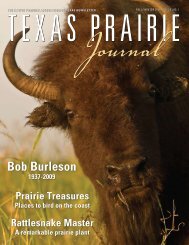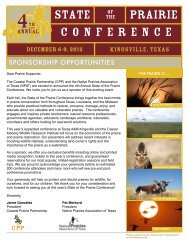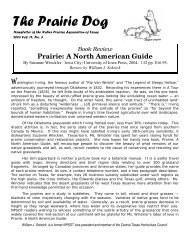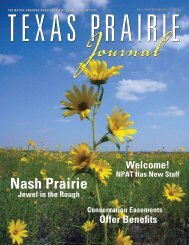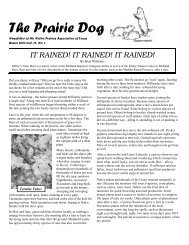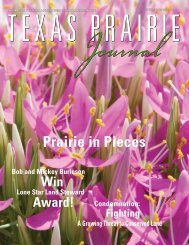2007 Fall/Winter issue - Native Prairies Association of Texas
2007 Fall/Winter issue - Native Prairies Association of Texas
2007 Fall/Winter issue - Native Prairies Association of Texas
Create successful ePaper yourself
Turn your PDF publications into a flip-book with our unique Google optimized e-Paper software.
Book Review<br />
By Roger Q. Jake Landers,<br />
Extension Specialist Emeritus<br />
Reprinted from the <strong>Native</strong> Plant Society<br />
<strong>of</strong> <strong>Texas</strong> Newsletter, Vol. 25, No 3.<br />
For those who find grasses challenging<br />
to identify, yet so appealing<br />
as to study them, the second volume<br />
has arrived to replace Hitchcock’s Manual<br />
<strong>of</strong> Grasses that has served us well for 75<br />
years. Flora <strong>of</strong> North America: North<br />
<strong>of</strong> Mexico Volume 24, Magnoliophyta:<br />
Commelinidae (in part): Poaceae, part I<br />
describes grasses <strong>of</strong> North America, north<br />
<strong>of</strong> Mexico, with exquisite line drawings,<br />
distribution maps, ecological characteristics<br />
and keys to identifications. It is 8¾˝ by<br />
11½˝ inches and 911 pages. It’s a tome,<br />
as my students used to say.<br />
The book has been assembled by the<br />
Grass Phylogeny Group <strong>of</strong> the Flora<br />
North America Project comprised <strong>of</strong><br />
13 individuals with editors Mary E.<br />
Barkworth, Kathleen M. Capels, Sandy<br />
Long, Laurel K. Anderton, and Michale<br />
B. Piepl. Illustrators are Cindy Talot<br />
Rohe, Linda Ann Vorobik, Sandy Long,<br />
Annaliese Miller, Bee F. Gunn and<br />
Christine Roberts.<br />
Volume 24 covers the BEP Clad (Bambusoi<br />
deae, Ehrharoideae, and Pooideae)<br />
containing familiar genera including<br />
Bambusa, Oryza, Melica, Stipa, Bromus,<br />
Elymus, Poa, Agrostis, Avena and many<br />
others. Volume 25 was published first so that<br />
the key and table <strong>of</strong> contents in the volume<br />
could correctly refer to its page locations.<br />
If you haven’t kept up with grass<br />
taxonomy in a while, be prepared for some<br />
unfamiliar names: Nasella for some <strong>of</strong><br />
the Stipas, Amelichloa, for other Stipas,<br />
Achnatherum for some <strong>of</strong> the others,<br />
Leymus, Pascopyrum, Pseudoroegneria,<br />
for wildryes and wheatgrasses, and many<br />
more. Keeping up with the changes may<br />
keep you young. That’s my only hope.<br />
Volume 24 is dedicated to “the two giants<br />
on whose shoulders we stand, Albert Spear<br />
Hitchcock and Mary Agnes Chase.” An<br />
historical introduction by M.T. Steiber gives<br />
a fascinating review <strong>of</strong> the lives and works <strong>of</strong><br />
Hitchcock and Chase.<br />
Flora <strong>of</strong> North America: North <strong>of</strong> Mexico<br />
Volume 24 is published by Oxford University<br />
Press, Inc., 198 Madison Ave., New York,<br />
N.Y. 10016. It can be found on Shop.com<br />
and Amazon.com.<br />
The Oaks and <strong>Prairies</strong><br />
Joint Venture<br />
A<br />
newly formed Oaks and<br />
<strong>Prairies</strong> Joint Venture (OPJV)<br />
has formed to join forces with<br />
other conservation organizations in an<br />
effort to improve and increase habitat<br />
for beleaguered birds in those regions.<br />
The Oaks and <strong>Prairies</strong> covers two bird<br />
conservation regions—the Edwards<br />
Plateau <strong>of</strong> Central <strong>Texas</strong> and the Oaks<br />
and <strong>Prairies</strong> <strong>of</strong> <strong>Texas</strong> and Oklahoma.<br />
Altered habitat conditions are resulting<br />
in declining numbers <strong>of</strong> important birds.<br />
Populations <strong>of</strong> once common birds such<br />
as the Northern Bobwhite have not only<br />
diminished, but are experiencing local<br />
extirpations. Fire suppression and fire<br />
fuel reduction via livestock grazing<br />
have lessened fire frequency resulting<br />
in accelerated development <strong>of</strong> shrub<br />
and tree species creating inhospitable<br />
landscapes for certain avian species.<br />
Most <strong>of</strong> the grassland habitat within the<br />
Post Oak Savannah Ecoregion has been<br />
converted to crop production or planted<br />
Bermuda grass. The end result <strong>of</strong> this<br />
process has been a decline in habitat for<br />
savannah and grassland-associated birds.<br />
Our ability to impact these drivers on<br />
a large scale, defines and will continue<br />
to define the extent to which we can be<br />
successful in managing avian-habitat<br />
resources in today’s world. However,<br />
management at the landscape scale is an<br />
exceedingly difficult task to which no one<br />
conservation entity is ideally suited and<br />
requires the combined efforts <strong>of</strong> a diverse<br />
group <strong>of</strong> natural resources partners.<br />
A Joint Venture is regional, selfdirected<br />
partnership <strong>of</strong> government<br />
and non-governmental organizations,<br />
corporations and individuals that works<br />
across administrative boundaries to<br />
deliver science-based avian conservation.<br />
JVs are organized on the biological<br />
foundation <strong>of</strong> Bird Conservation Regions<br />
(BCRs) and raise money for these<br />
activities. JVs are not regulatory, and are<br />
led by a Management Board made up <strong>of</strong><br />
partner representatives.<br />
The OPJV <strong>of</strong>fers a partner-based<br />
framework for developing, implementing,<br />
and testing landscape-scale management<br />
strategies for improving avian habitat<br />
conditions. Bringing a wide range <strong>of</strong><br />
partner organizations to the table is key<br />
to this process. In fact, Joint Ventures<br />
is a collection <strong>of</strong> partners working<br />
towards common goals in a structured<br />
fashion. The Concept Plan is based on<br />
conversations with conservationists<br />
throughout the region. It will be followed<br />
by an Implementation Plan that outlines<br />
specific goals and objectives, and the<br />
mechanisms for making them happen.<br />
When completed the Implementation<br />
Plan will be submitted to the US Fish<br />
and Wildlife Service for review, and with<br />
their approval, the OPJV will become<br />
a federally recognized, and federally<br />
funded Joint Venture.<br />
Ultimately the success <strong>of</strong> this Joint<br />
Venture hinges on the participation<br />
<strong>of</strong> conservation partners. There are a<br />
number <strong>of</strong> avenues for involvement<br />
with the OPJV including cooperation<br />
in implementing specific projects,<br />
working with technical teams to<br />
develop management plans and research<br />
proposals, or membership on the<br />
Management Board. The next step will<br />
be an initial OPJV meeting which will<br />
focus on organization, commitment,<br />
partner roles and responsibilities and<br />
development <strong>of</strong> the Implementation Plan.<br />
We value interest and input into this<br />
process and ask that you consider what<br />
role your organization might plan in this<br />
collaborative effort to shape the future <strong>of</strong><br />
avian habitat conservation in the Edwards<br />
Plateau and Oaks and <strong>Prairies</strong> regions.<br />
Compiled from a letter dated May 7,<br />
<strong>2007</strong> and from “Oaks & <strong>Prairies</strong> Joint<br />
Venture: A Vision for Regional Bird<br />
Management”<br />
For more information, download a pdf<br />
booklet from http://www.tpwd.state.tx.us/<br />
publications/pwdpubs/media/pwd_bk_<br />
w7000_1220.pdf<br />
[Editor’s Note: NPAT is a partner in the<br />
Oaks and <strong>Prairies</strong> Joint Venture.]<br />
<strong>Fall</strong>/<strong>Winter</strong> <strong>2007</strong><br />
native <strong>Prairies</strong> <strong>Association</strong> <strong>of</strong> <strong>Texas</strong><br />
11


